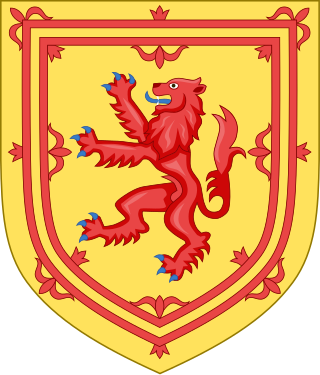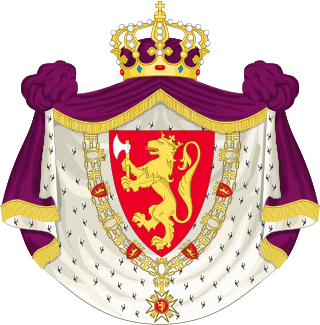A monarchy is a form of government in which a person, the monarch, reigns as head of state for life or until abdication. The extent of the authority of the monarch may vary from restricted and largely symbolic, to fully autocratic, and may have representational, executive, legislative, and judicial functions.

Margrethe II is a member of the Danish royal family who reigned as Queen of Denmark from 14 January 1972 until her abdication on 14 January 2024. Having reigned for exactly 52 years, she was the second-longest reigning Danish monarch after Christian IV. She is also the world's most recent female reigning monarch.

A motto is a sentence or phrase expressing a belief or purpose, or the general motivation or intention of an individual, family, social group, or organization. Mottos are usually found predominantly in written form, and may stem from long traditions of social foundations, or from significant events, such as a civil war or a revolution. One's motto may be in any language, but Latin has been widely used, especially in the Western world.

Christian V was King of Denmark and Norway from 1670 until his death in 1699.
The royal motto of the Swedish monarch is a Swedish royal tradition stemming from the early 16th century. All reigning monarchs of Sweden, beginning with Gustav I, have had their own mottos during their respective periods of reign. The Swedish royal motto in many ways is equivalent to a national motto. The tradition among Swedish monarchs, in common with the Danish and Norwegian monarchies, but different from that of most other modern European monarchies, is that the motto is not the same for one dynasty, but is personal to each monarch. Historically the royal motto has been used in connection with the Swedish coat of arms, and until 30 June 2017 it could be seen in print on the 1 krona coin. The new generation of coins does not feature a motto.

Dieu et mon droit, which means 'God and my right', is the motto of the monarch of the United Kingdom. It appears on a scroll beneath the shield of the version of the coat of arms of the United Kingdom used outside Scotland. The motto is said to have first been used by Richard I (1157–1199) as a battle cry and presumed to be a reference to his French ancestry and the concept of the divine right of the monarch to govern. It was adopted as the royal motto of England by King Henry V (1386–1422), with the phrase "and my right" referring to his claim by descent to the French crown.

The Order of the Dannebrog is a Danish order of chivalry instituted in 1671 by Christian V. Until 1808, membership in the Order was limited to fifty members of noble or royal rank, who formed a single class known as White Knights to distinguish them from the Blue Knights who were members of the Order of the Elephant. In 1808, the Order was reformed and divided into four classes. The statute of the Order was amended in 1951 by a Royal Ordinance so that both men and women could be members of the Order. Today, the Order of the Dannebrog is a means of honouring and rewarding the faithful servants of the modern Danish state for meritorious civil or military service, for a particular contribution to the arts, sciences or business life, or for working for Danish interests.

Christiansborg Palace is a palace and government building on the islet of Slotsholmen in central Copenhagen, Denmark. It is the seat of the Danish Parliament, the Danish Prime Minister's Office, and the Supreme Court of Denmark. Also, several parts of the palace are used by the Danish monarch, including the Royal Reception Rooms, the Palace Chapel and the Royal Stables.

Princess is a title used by a female member of a regnant monarch's family or by a female ruler of a principality. The male equivalent is a prince. Most often, the term has been used for the consort of a prince, or for the daughter of a monarch. A crown princess can be the heir apparent to the throne or the spouse of the heir apparent.

The House of Bjälbo, also known as the House of Folkung, was a Swedish family that produced several medieval bishops, jarls and kings of Sweden. It also provided three kings of Norway and one king of Denmark in the 14th century.

The coat of arms of Scotland, colloquially called the Lion Rampant, is the coat of arms historically used as arms of dominion by the monarchs of the Kingdom of Scotland, and later used within the coat of arms of Great Britain and the present coat of arms of the United Kingdom. The arms consist of a red lion surrounded by a red double border decorated with fleurs-de-lis, all on a gold background. The blazon, or heraldic description, is: Or a lion rampant Gules armed and langued Azure within a double tressure flory-counter-flory of the second.
Royal Mottos may refer to:

The Norwegian monarch is the head of state of Norway, which is a constitutional and hereditary monarchy with a parliamentary system. The Norwegian monarchy can trace its line back to the reign of Harald Fairhair and the previous petty kingdoms which were united to form Norway; it has been in unions with both Sweden and Denmark for long periods.
The Royal mottos of the Norwegian monarchs are an old tradition of Norway, permanent since the reign of Christian II of Denmark and Norway. The latest three kings have adopted the same motto as their personal motto, Alt for Norge, that has a particularly high standing as it became one of the main symbols of the Norwegian struggle during the German occupation in World War II.

The monarchy of Denmark is a constitutional institution and a historic office of the Kingdom of Denmark. The Kingdom includes Denmark proper and the autonomous territories of the Faroe Islands and Greenland. The Kingdom of Denmark was already consolidated in the 8th century, whose rulers are consistently referred to in Frankish sources as "kings". Under the rule of King Gudfred in 804 the Kingdom may have included all the major provinces of medieval Denmark.
A national coat of arms is a symbol which denotes an independent state in the form of a heraldic achievement. While a national flag is usually used by the population at large and is flown outside and on ships, a national coat of arms is normally considered a symbol of the government or the head of state personally and tends to be used in print, on armorial ware, and as a wall decoration in official buildings. The royal arms of a monarchy, which may be identical to the national arms, are sometimes described as arms of dominion or arms of sovereignty.

Heraldic badges of the Royal Air Force are the insignia of certain commands, squadrons, units, wings, groups, branches and stations within the Royal Air Force. They are also commonly known as crests, especially by serving members of the Royal Air Force, but officially they are badges. Each badge must be approved by the reigning monarch of the time, and as such will either have a King's or Queen's Crown upon the top of the badge, dependent upon which monarch granted approval and the disbandment date of the unit. The approval process involves a member of the College of Arms who acts as an advisory on all matters pertaining to the design and suitability of the insignia and motto.

Regna firmat pietas is a Latin phrase translated in English as "Piety strengthens the realms". The phrase was used as the royal motto for Denmark–Norway during the reign of Christian IV and sought to promote Lutheranism as a strength for the nation.